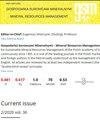Research of Co2+ ions removal from water solution by using ion exchangers
IF 0.8
4区 工程技术
Q4 MINERALOGY
Gospodarka Surowcami Mineralnymi-Mineral Resources Management
Pub Date : 2023-07-20
DOI:10.24425/122583
引用次数: 0
Abstract
At present, industrial development is increasing pollution of soils, air and natural waters. These pollutants have a negative effect on the health and life of living organisms. Metals which interfere with the natural biological balance and inhibit self-cleaning processes in water bodies have particularly toxic effects. Cobalt, which gets into the environment from industrial sewage from electrochemical plants and the metallurgical industry, also belong to this group. This is also relatively rare and precious element, so it is important to look for additional sources of its recovery. Chemical and physicochemical methods such as: precipitation, extraction, membrane processes – nanofiltration, reverse osmosis, sorption and ion exchange are used to recover cobalt. The choice of method depends on: the kind and composition of wastewaters as well as on form and concentration of the pollutants. Ion exchange resins produced by Purolite which were used to remove cobalt ions from solutions with concentrations corresponding to its contents in galvanic wastewater was the subject of the study. It has been shown that the C 160 ion exchange resin has the best the sorption properties for Co 2+ ions (54.7 mg/g). In case of this ion exchange resin, after sorption process carried out in one 50 minute cycle, cobalt concentration decreased from about 30 g/L to about 9 g/L. The values of the sorption capacity do not depend on the method of introducing the solution into an ion exchange column (pouring or drop-ping). each of the tested ion exchange resins is characterized by a high degree of cobalt concentration after regeneration using mineral acids, which can be advantageous in selecting the recovery method for this metal.离子交换剂去除水中Co2+离子的研究
目前,工业发展加剧了土壤、空气和自然水体的污染。这些污染物对生物的健康和生命有负面影响。干扰自然生物平衡和抑制水体自清洁过程的金属具有特别的毒性作用。从电化学工厂和冶金工业的工业污水中进入环境的钴也属于这一类。这也是相对稀有和珍贵的元素,因此寻找其回收的其他来源是很重要的。化学和物理化学方法,如:沉淀,萃取,膜工艺-纳滤,反渗透,吸附和离子交换用于回收钴。方法的选择取决于废水的种类和成分以及污染物的形式和浓度。以Purolite生产的离子交换树脂为研究对象,该树脂用于去除电解废水中钴离子浓度对应的溶液中的钴离子。实验结果表明,c160离子交换树脂对Co 2+的吸附性能最好(54.7 mg/g)。在该离子交换树脂中,经过一个50分钟循环的吸附过程后,钴浓度从约30 g/L下降到约9 g/L。吸附容量的值不取决于将溶液引入离子交换柱的方法(浇注或滴注)。每种测试的离子交换树脂在使用无机酸再生后都具有很高的钴浓度,这对于选择这种金属的回收方法是有利的。
本文章由计算机程序翻译,如有差异,请以英文原文为准。
求助全文
约1分钟内获得全文
求助全文
来源期刊
CiteScore
1.80
自引率
11.10%
发文量
0
审稿时长
>12 weeks
期刊介绍:
Gospodarka Surowcami Mineralnymi – Mineral Resources Management is a journal of the MEERI PAS and the Committee for Sustainable Mineral Resources Management of the Polish Academy of Sciences. The journal has been published continuously since 1985. It is one of the leading journals in the Polish market, publishing original scientific papers by Polish and foreign authors in the field broadly understood as the management of mineral resources. Articles are published in English. All articles are reviewed by at least two independent reviewers (the Editorial Board selects articles according to the “double-blind review” principle).

 求助内容:
求助内容: 应助结果提醒方式:
应助结果提醒方式:


